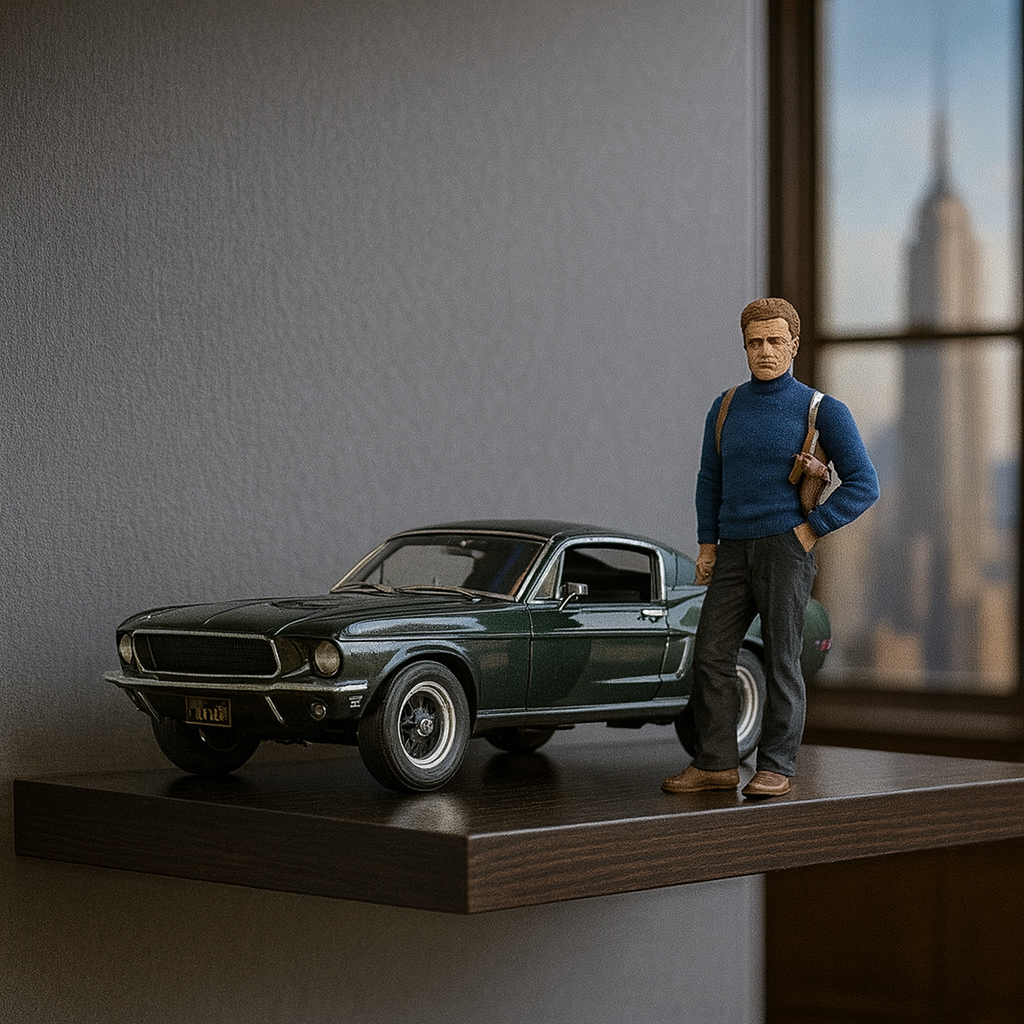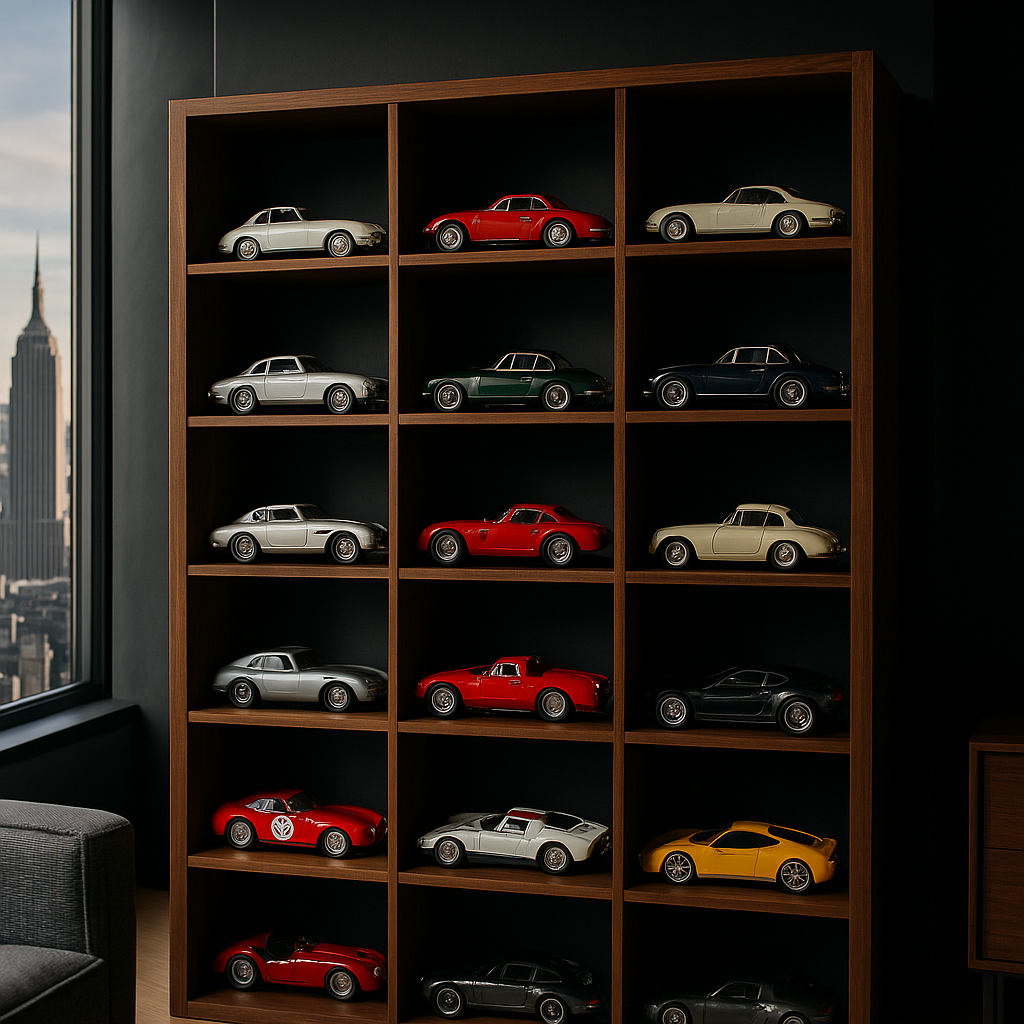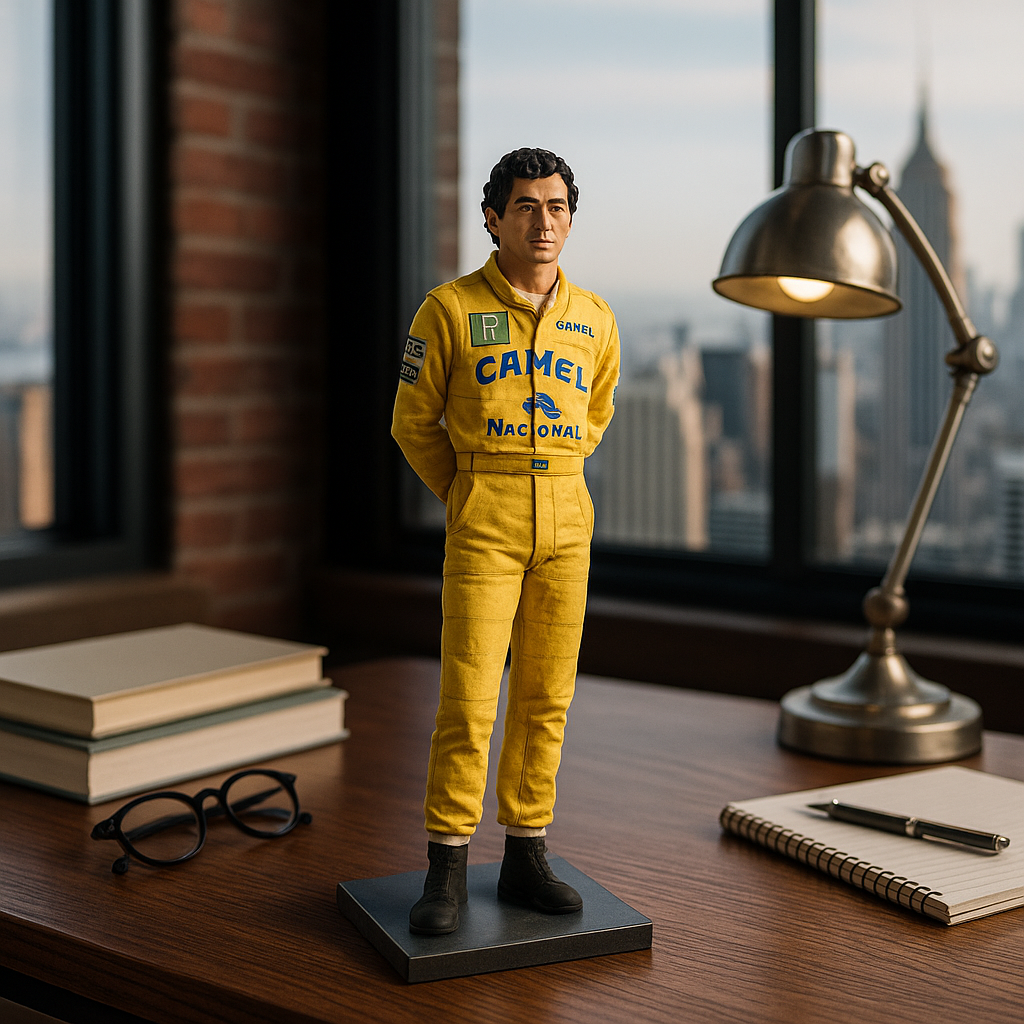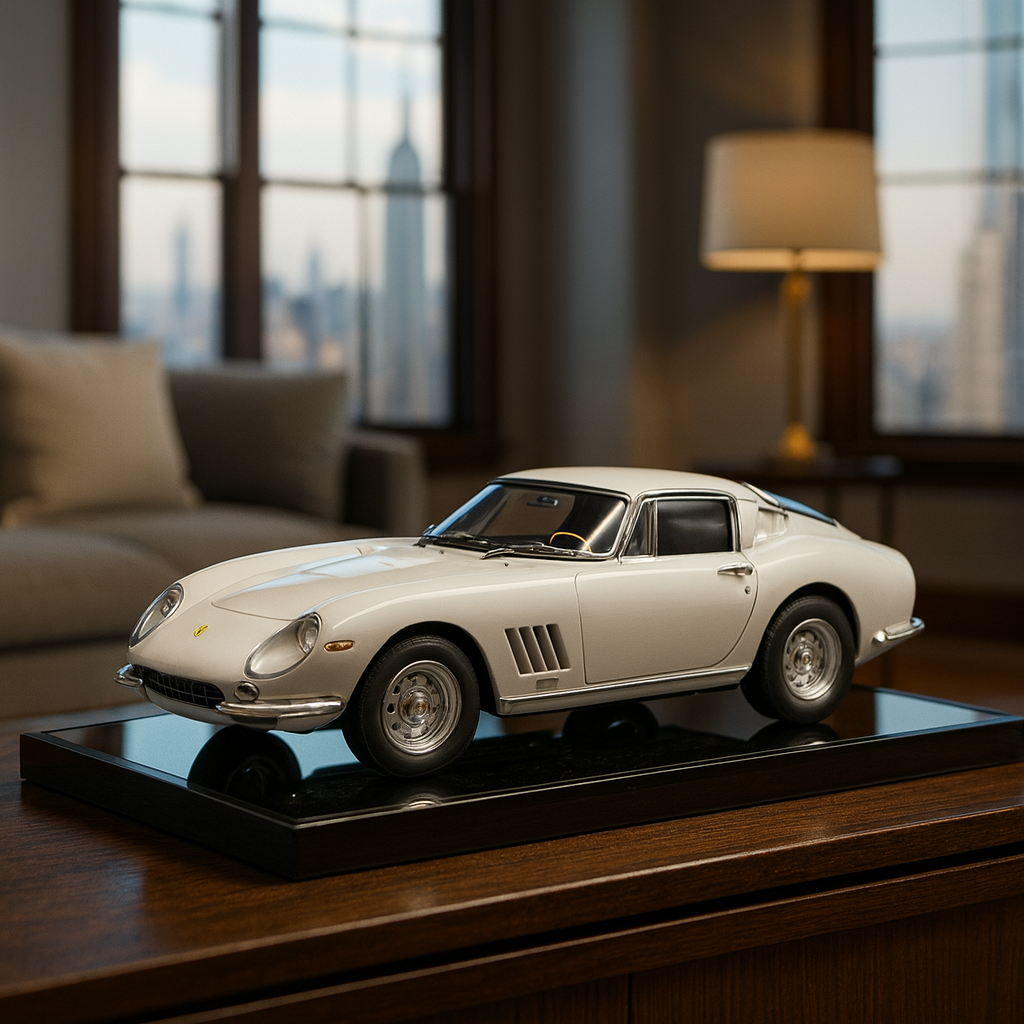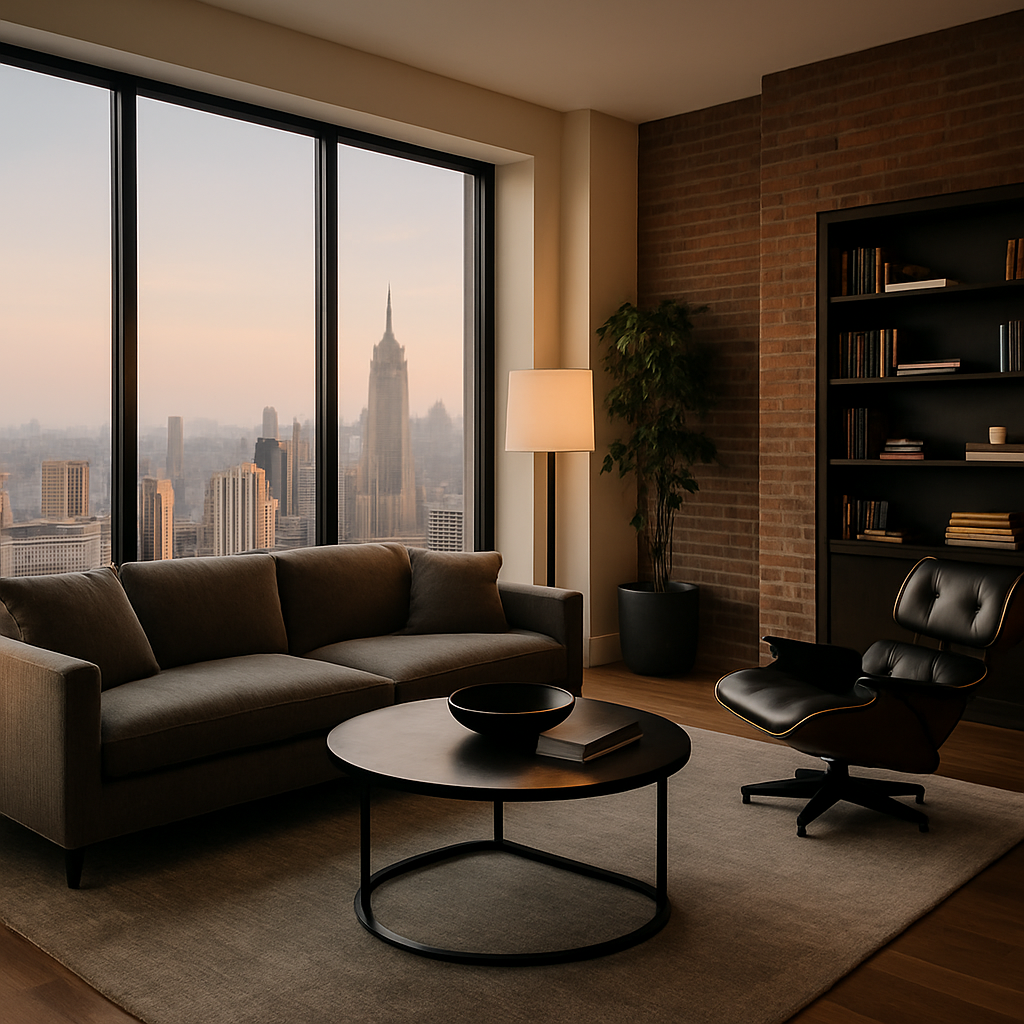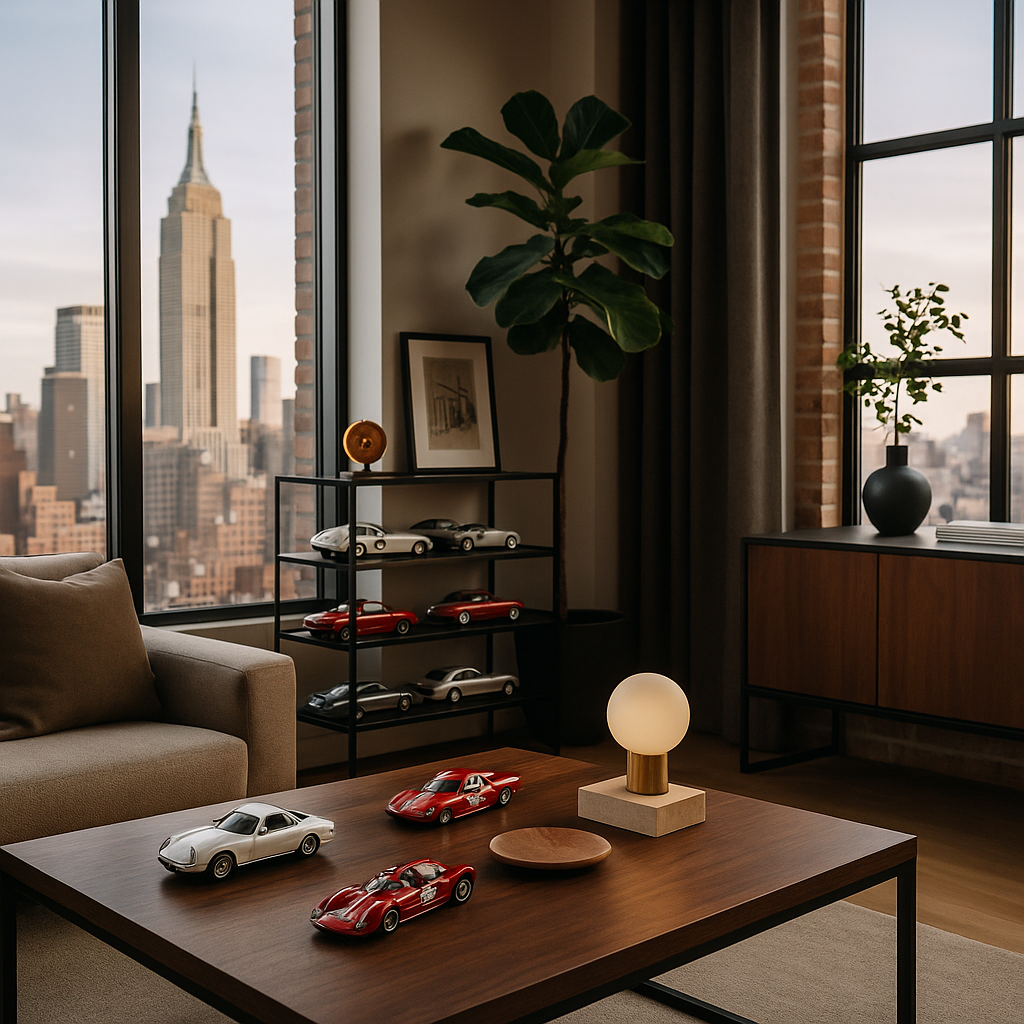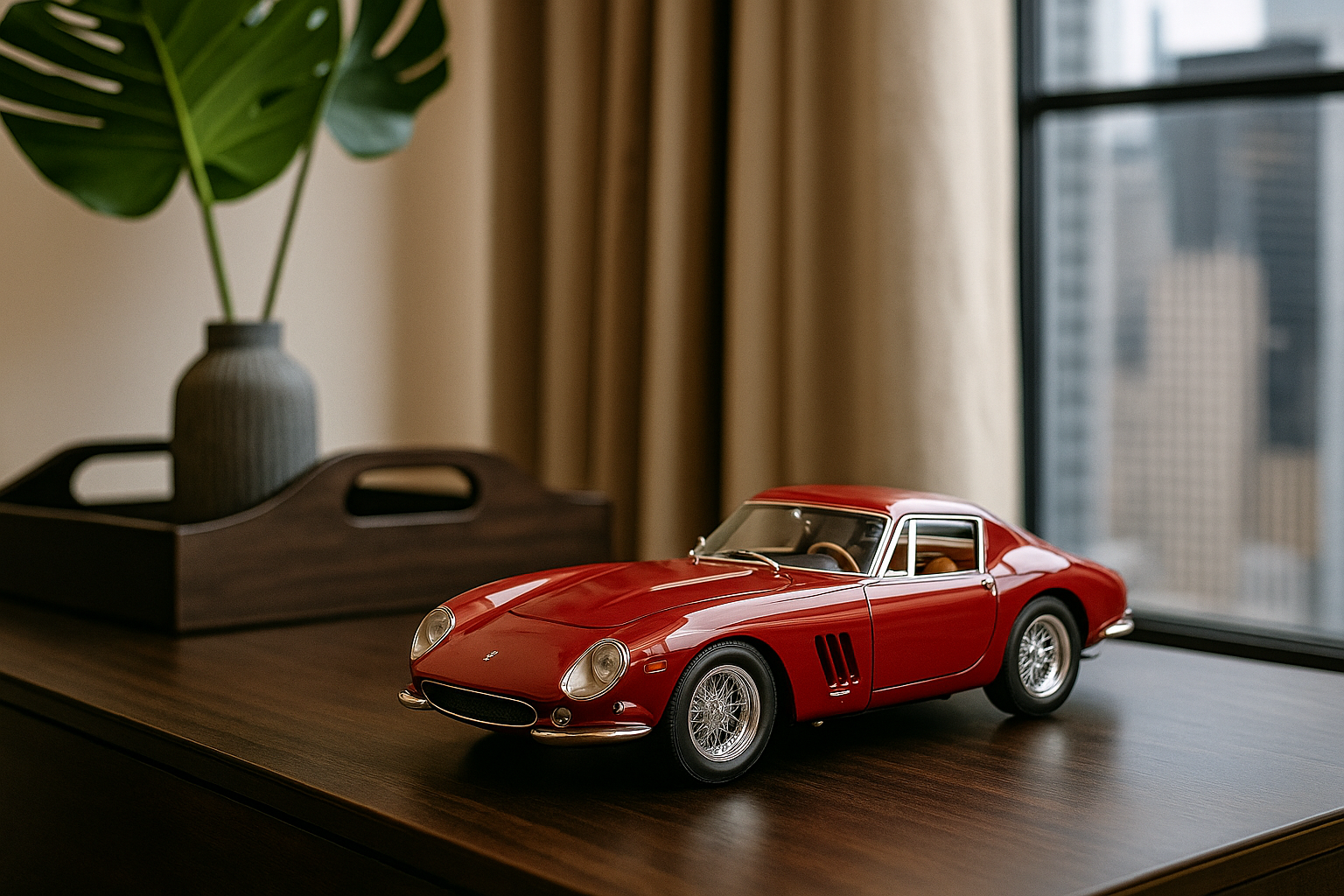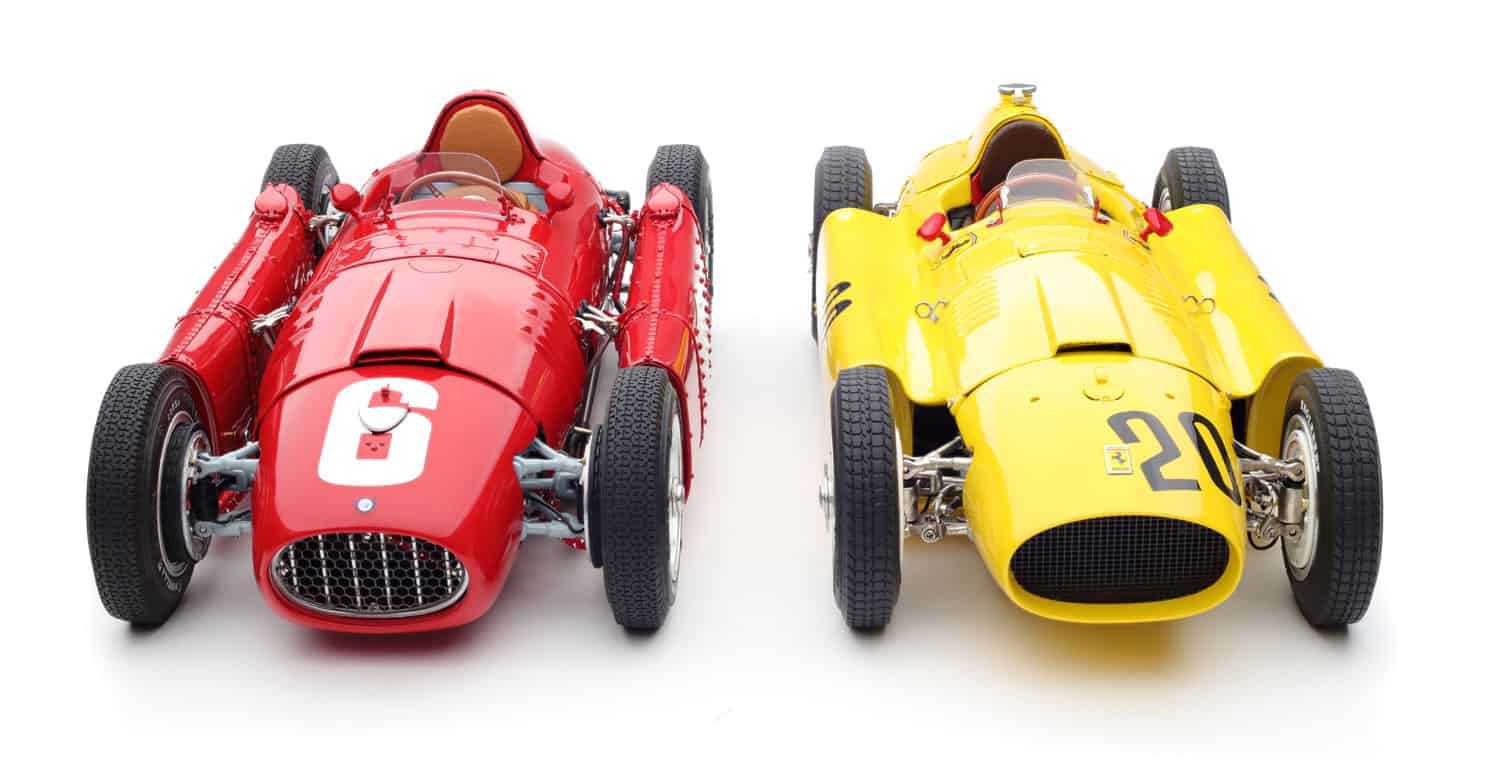
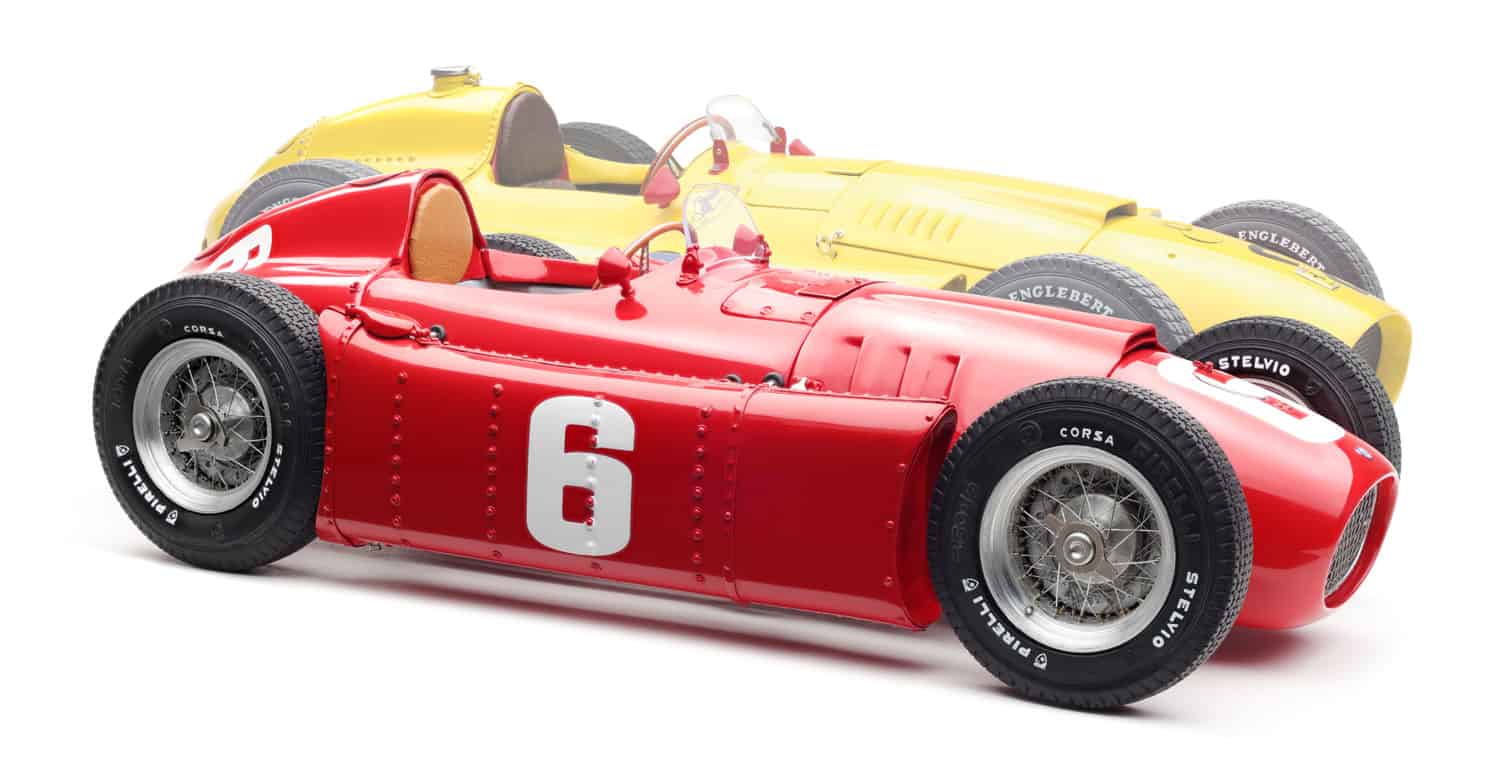
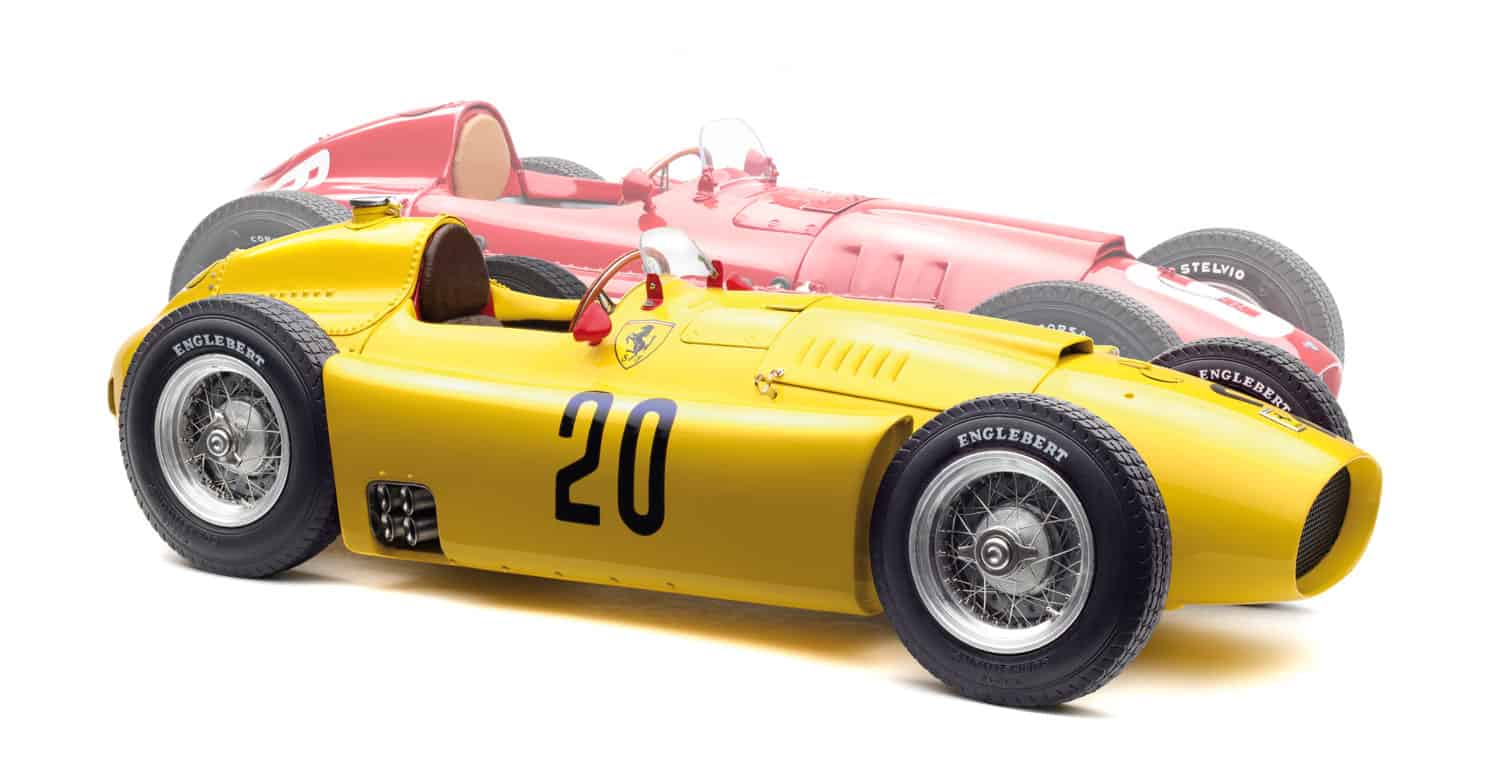
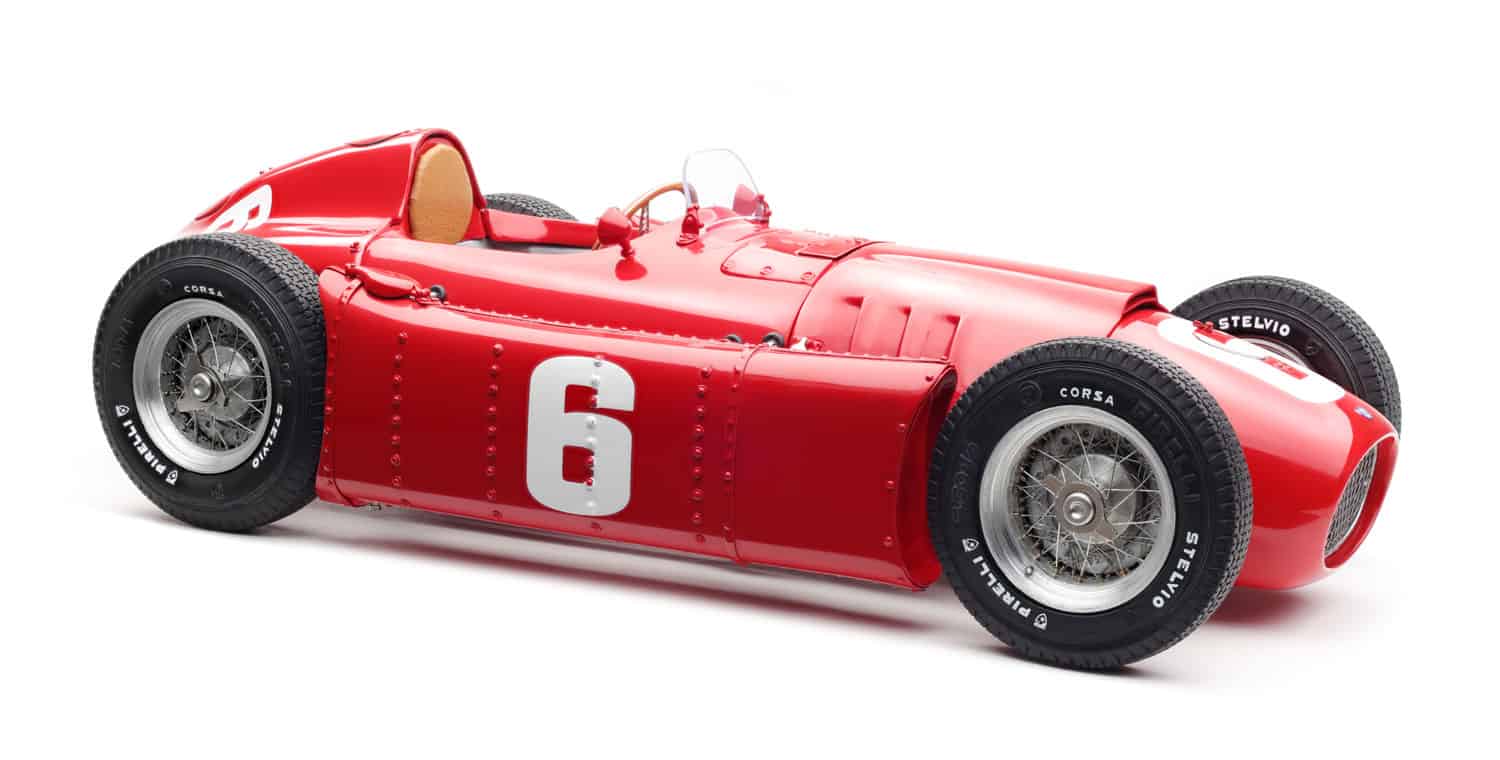
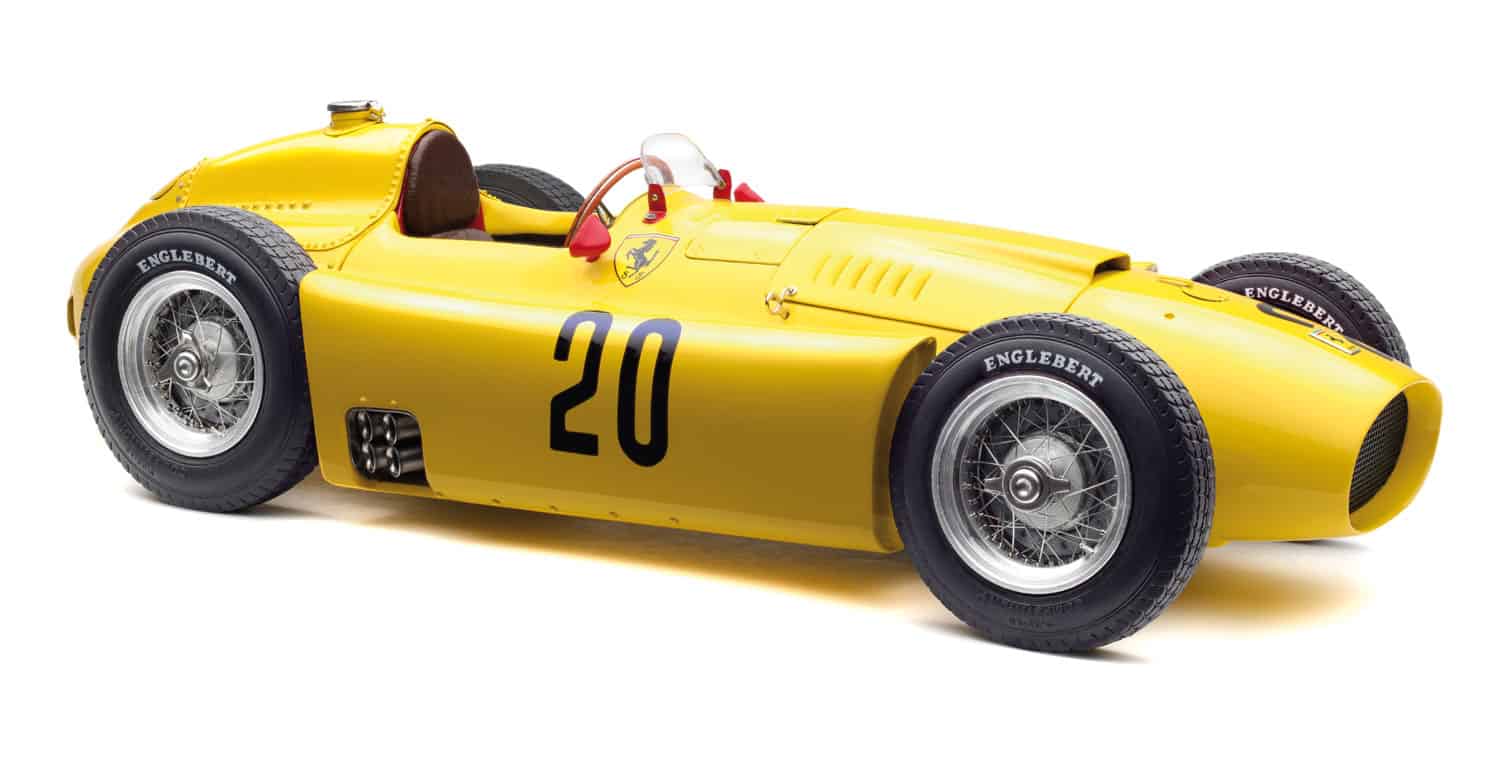
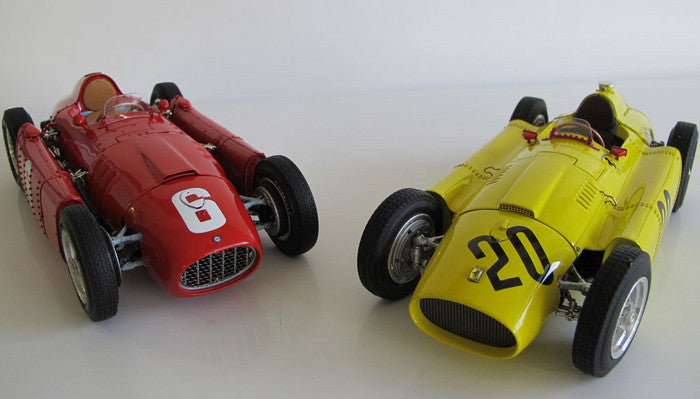
Bundle Ferrari D50 #20 Pilette + Lancia D50 #6 Ascari CMC M-184 LE 1,000

Description
For CMC, it was an exciting task to bring the interesting development history of the D50 closer to its customers in the form of a bundle.
The bundle includes 2 models, of which the model with starting number 6 is a Lancia representative from 1955 and the model with starting number 20 represents the more developed version as a Ferrari D50 from 1956.
Introduction of the individual models:
CMC Lancia D50
Grand Prix of Turin/Italy, 1955
Alberto Ascari #6, 1st place
Scale 1:18
On March 27, 1955, the Torino GP (also known as the Gran Premio del Valentino) took place in Turin, the capital of Piedmont, Italy. The circuit consisted of 90 laps of 4.2 km each, corresponding to a total race distance of 378.0 km. The event was not counted as a World Championship race.
The field consists of three racing teams: Lancia, Ferrari, and Maserati. Lancia entered its star driver, Alberto Ascari, in the number 6 car, alongside Eugenio Castellotti and Luigi Villoresi. Maserati fielded a very strong lineup, with Jean Behra, Luigi Musso, and Cesare Perdisa considered the best chances of winning. Ferrari tried its luck with Harry Schell, Maurice Trintingnant, Guiseppe Farina, and Alfonso de Portago, to name the most promising candidates for this team.
The Lancia D50s dominated practice, and Alberto Ascari secured pole position with a lap time of 1:42.0 minutes. Jean Behra took second place on the front row in his Maserati 250F, which was just 0.2 seconds slower than Ascari. Luigi Musso took third place on the front row with a lap time of 1:43.1 minutes. Starting from the second row were Farina in a Ferrari, Roberto Mieres in a Maserati 250F, and Villoresi in a Lancia D50. Trintingnant in a Ferrari and Castellotti in a Lancia followed.
After various battles for position between the three racing teams, Ascari took the lead on lap 22 and steadily increased his advantage. He was able to overtake his teammate Castellotti after lap 60.
After 90 laps, the finish line was crossed in the order Villoresi, Castellotti and Ascari.
The clear winner was, of course, Alberto Ascari, who had a one-lap advantage over the others and won the race in 2 hours and 40 minutes. Roberto Mieres achieved a respectable second place for Maserati. Harry Schell, the only Ferrari driver to finish, finished fifth.
With this success, Alberto Ascari secured Lancia's first Grand Prix victory. It was also a personal triumph after a long dry spell, as his last victory had been at the Swiss Grand Prix in 1953.
Note: The Ascari Model #6 has two different construction stages compared to the Monaco standard model (item no. M-175). The hood is equipped with only three ventilation gills, and the oil cooler has been relocated to the front of the engine.
CMC Ferrari D50
Belgian Grand Prix, 1956
André Pilette #20, 6th place
Scale 1:18
The 1965 Belgian Grand Prix took place on 3 June 1956 at the Circuit de Spa-Francorchamps near the town of Spa and was also the fourth race of the 1956 Automobile World Championship.
36 laps of 14.12 km each had to be completed, which corresponded to a total race distance of 508.32 km.
As in the previous races, the two Italian racing teams once again set the tone. Both top teams fielded five drivers each. In addition to its regular drivers Fangio, Castellotti, and Peter Collins, Ferrari fielded two cars for the Belgian national heroes Paul Frère and André Pilette. Although André Pilette hasn't yet emerged as a driver with a strong track record, we chose the bundle for his car as the model for our Ferrari D50 model selection. We wanted to finally add some variety to the "dominant" Ferrari red with a yellow paint job (the Belgian racing color).
For Maserati, alongside regular drivers Behra, Stirling Moss, and Cesare Perdisa, Chico Godia and Englishman Mike Hawthorn competed. The English racing team Vanwall also returned, fielding Harry Schell and Maurice Trintignant. The field was also supplemented by several private drivers.
Juan Manuel Fangio secured pole position in practice. Moss held on to second place, followed by Collins in third. Jean Behra, the leader in the Drivers' Championship, took fourth place. Both Vanwalls qualified behind Castellotti in fifth place. The two Belgian national heroes took the lower positions.
The starting flag dropped, and Moss immediately took the lead. Fangio once again lost several places, but was soon able to settle into fourth place behind Moss, Collins, and Castellotti. At this point, Maserati was leading ahead of three Ferraris. Fangio steadily increased the pace and, although still six seconds behind, slowly but surely closed the gap to the leading Moss. Already on lap five, Fangio overtook Moss and moved to the front of the field. Fangio increased his lead to a respectable eight seconds by lap ten.
On lap ten, a series of retirements began to disrupt the standings. Castellotti was forced to retire due to a technical defect in his car. Stirling Moss's wheel came loose, causing him to spin off the track. This allowed Collins to move up to second place, giving Ferrari a one-two lead. Moss reached his nearby pit lane after a steady run and took over from Perdisa, but he was one lap behind the leader, Fangio.
On lap 23, Fangio was caught out. Due to insufficient fuel supply to the engine, his race ended. Collins then took the lead for the first time in his racing career and held it until the end. Behra and Frère battled for second place in the final third of the race until Behra dropped to seventh due to engine problems.
After Moss was able to continue the race with his teammate Perdisa's car, he fought courageously to the front and ended up taking a podium place with third place.
In the end, the radiant winner was Peter Collins, giving Ferrari its second win of the season. Frère secured second place in his final race, completing a Ferrari one-two finish. Harry Schell crossed the finish line in fourth, one lap behind.
Due to the numerous retirements, but also due to a consistent and thoughtful driving style, our role model for the bundle model, André Pilette, was able to secure a respectable sixth place.
Model descriptions:
Ferrari D50:
- Metal precision model made of 1161 parts, hand-assembled.
- Removable and lockable hood
- Movable ventilation flap for the driver's footwell
- True to the original replica of the 8-cylinder 90°V engine with all
- Add-on units and complete cable laying/cabling
- Exhaust pipes as side pipes in metal design
- Metal wishbone front axle with shock absorbers and transverse leaf spring
- DeDion metal rear axle with tension struts and shock absorbers and transverse leaf spring
- Handcrafted stainless steel grille
- Tubular oil cooler in front of the water cooler
- Detailed replica of the cooling system as well as the oil and fuel lines
- Movable tank caps, movable oil filler cap
- Cockpit with leather-covered driver's seat and headrest
- Perfectly designed spoked wheels with hand-drawn and nippled stainless steel wire spokes mounted on aluminum rims
- Original central locking devices with right/left thread
- Brilliant paintwork in original color
- Start numbers applied using a complex pad printing process
Special accessory: Battery starter trolley with separate external starter
Lancia D50:
- Metal precision model made of 1,598 parts, hand-assembled.
- Removable and lockable hood
- Movable windshield
- True to the original replica of the 8-cylinder 90°V engine with all
- Add-on units and complete cable laying/cabling
- Both exhaust pipes in metal design
- Metal wishbone front axle with oil-pressure shock absorbers
- De Dion metal rear axle with trailing arms and oil-pressure shock absorbers
- Handcrafted, painted stainless steel grille with metal struts
- Detailed replica of the cooling system
- Detailed laying of oil and fuel lines
- Movable tank caps
- Movable oil filler cap
- Cockpit with leather-covered driver's seat and headrest
- Perfectly designed spoked wheels with hand-drawn and nippled stainless steel wire spokes
- Screwable wheel center locks with authentic right/left thread
- Brilliant paintwork in original color
- Start numbers applied using a complex pad printing process
Special accessory: Battery starter trolley with separate external starter
Technical data of the original vehicles:
Ferrari D50:
- Monoposto with free-standing wheels built on a tubular frame
- Load-bearing 8-cylinder 90° V-engine
- 2 valves per cylinder, controlled by two overhead camshafts each
- Dry sump lubrication
- Mixture preparation with four Solex 40 PII double downdraft carburettors
- Magneto dual ignition with two spark plugs per cylinder
- 5-speed gearbox mounted transversely at the rear with limited-slip differential (transaxle)
- Front axle with double wishbones, a leaf spring transversely under the axle, stabilizer and telescopic shock absorbers
- De Dion rear axle with trailing arm, a leaf spring across the axle and lever shock absorbers
| Bore x stroke: | 76 x 68.5 mm |
| Engine capacity: | 2,486 cc |
| Perfomance: | 265 hp at 8,000 rpm |
| Top speed: | up to 300 km/h (depending on rear axle ratio) |
| Wheelbase: | 2,280 mm |
| Front/rear track: | 1270/1270 mm |
| Total length: | 3,850 mm |
| Total width: | 1,448 mm |
| Total height: | 962 mm |
| Empty weight: | 640 kg |
Lancia D50:
- Monoposto with free-standing wheels built on a tubular frame
- 8-cylinder 90°V engine as a load-bearing chassis element
- 2 valves per cylinder, controlled by two overhead camshafts each
- Dry sump lubrication
- Mixture preparation with four Solex PII flat-flow twin carburettors
- Dual ignition (two spark plugs per cylinder)
- Transversely mounted five-speed gearbox behind the driver
| Bore x stroke: | 73.6 x 73.1 mm |
| Engine capacity: | 2,488 cc |
| Perfomance: | 260 hp at 8,000 rpm |
| Top speed: | 300 km/h (depending on rear axle ratio) |
| Wheelbase: | 2,280 mm |
| Front/rear track: | 1,294 / 1,330 mm |
| Total length: | 3. 570 mm |
| Total width: | 1,600 mm |
| Total height: | 1,001 mm |
| Empty weight: | 620 kg |
Notice
For CMC, it was an exciting task to bring the interesting development history of the D50 closer to its customers in the form of a bundle.
The bundle includes 2 models, of which the model with starting number 6 is a Lancia representative from 1955 and the model with starting number 20 represents the more developed version as a Ferrari D50 from 1956.
Introduction of the individual models:
CMC Lancia D50
Grand Prix of Turin/Italy, 1955
Alberto Ascari #6, 1st place
Scale 1:18
On March 27, 1955, the Torino GP (also known as the Gran Premio del Valentino) took place in Turin, the capital of Piedmont, Italy. The circuit consisted of 90 laps of 4.2 km each, corresponding to a total race distance of 378.0 km. The event was not counted as a World Championship race.
The field consists of three racing teams: Lancia, Ferrari, and Maserati. Lancia entered its star driver, Alberto Ascari, in the number 6 car, alongside Eugenio Castellotti and Luigi Villoresi. Maserati fielded a very strong lineup, with Jean Behra, Luigi Musso, and Cesare Perdisa considered the best chances of winning. Ferrari tried its luck with Harry Schell, Maurice Trintingnant, Guiseppe Farina, and Alfonso de Portago, to name the most promising candidates for this team.
The Lancia D50s dominated practice, and Alberto Ascari secured pole position with a lap time of 1:42.0 minutes. Jean Behra took second place on the front row in his Maserati 250F, which was just 0.2 seconds slower than Ascari. Luigi Musso took third place on the front row with a lap time of 1:43.1 minutes. Starting from the second row were Farina in a Ferrari, Roberto Mieres in a Maserati 250F, and Villoresi in a Lancia D50. Trintingnant in a Ferrari and Castellotti in a Lancia followed.
After various battles for position between the three racing teams, Ascari took the lead on lap 22 and steadily increased his advantage. He was able to overtake his teammate Castellotti after lap 60.
After 90 laps, the finish line was crossed in the order Villoresi, Castellotti and Ascari.
The clear winner was, of course, Alberto Ascari, who had a one-lap advantage over the others and won the race in 2 hours and 40 minutes. Roberto Mieres achieved a respectable second place for Maserati. Harry Schell, the only Ferrari driver to finish, finished fifth.
With this success, Alberto Ascari secured Lancia's first Grand Prix victory. It was also a personal triumph after a long dry spell, as his last victory had been at the Swiss Grand Prix in 1953.
Note: The Ascari Model #6 has two different construction stages compared to the Monaco standard model (item no. M-175). The hood is equipped with only three ventilation gills, and the oil cooler has been relocated to the front of the engine.
CMC Ferrari D50
Belgian Grand Prix, 1956
André Pilette #20, 6th place
Scale 1:18
The 1965 Belgian Grand Prix took place on 3 June 1956 at the Circuit de Spa-Francorchamps near the town of Spa and was also the fourth race of the 1956 Automobile World Championship.
36 laps of 14.12 km each had to be completed, which corresponded to a total race distance of 508.32 km.
As in the previous races, the two Italian racing teams once again set the tone. Both top teams fielded five drivers each. In addition to its regular drivers Fangio, Castellotti, and Peter Collins, Ferrari fielded two cars for the Belgian national heroes Paul Frère and André Pilette. Although André Pilette hasn't yet emerged as a driver with a strong track record, we chose the bundle for his car as the model for our Ferrari D50 model selection. We wanted to finally add some variety to the "dominant" Ferrari red with a yellow paint job (the Belgian racing color).
For Maserati, alongside regular drivers Behra, Stirling Moss, and Cesare Perdisa, Chico Godia and Englishman Mike Hawthorn competed. The English racing team Vanwall also returned, fielding Harry Schell and Maurice Trintignant. The field was also supplemented by several private drivers.
Juan Manuel Fangio secured pole position in practice. Moss held on to second place, followed by Collins in third. Jean Behra, the leader in the Drivers' Championship, took fourth place. Both Vanwalls qualified behind Castellotti in fifth place. The two Belgian national heroes took the lower positions.
The starting flag dropped, and Moss immediately took the lead. Fangio once again lost several places, but was soon able to settle into fourth place behind Moss, Collins, and Castellotti. At this point, Maserati was leading ahead of three Ferraris. Fangio steadily increased the pace and, although still six seconds behind, slowly but surely closed the gap to the leading Moss. Already on lap five, Fangio overtook Moss and moved to the front of the field. Fangio increased his lead to a respectable eight seconds by lap ten.
On lap ten, a series of retirements began to disrupt the standings. Castellotti was forced to retire due to a technical defect in his car. Stirling Moss's wheel came loose, causing him to spin off the track. This allowed Collins to move up to second place, giving Ferrari a one-two lead. Moss reached his nearby pit lane after a steady run and took over from Perdisa, but he was one lap behind the leader, Fangio.
On lap 23, Fangio was caught out. Due to insufficient fuel supply to the engine, his race ended. Collins then took the lead for the first time in his racing career and held it until the end. Behra and Frère battled for second place in the final third of the race until Behra dropped to seventh due to engine problems.
After Moss was able to continue the race with his teammate Perdisa's car, he fought courageously to the front and ended up taking a podium place with third place.
In the end, the radiant winner was Peter Collins, giving Ferrari its second win of the season. Frère secured second place in his final race, completing a Ferrari one-two finish. Harry Schell crossed the finish line in fourth, one lap behind.
Due to the numerous retirements, but also due to a consistent and thoughtful driving style, our role model for the bundle model, André Pilette, was able to secure a respectable sixth place.
Model descriptions:
Ferrari D50:
- Metal precision model made of 1161 parts, hand-assembled.
- Removable and lockable hood
- Movable ventilation flap for the driver's footwell
- True to the original replica of the 8-cylinder 90°V engine with all
- Add-on units and complete cable laying/cabling
- Exhaust pipes as side pipes in metal design
- Metal wishbone front axle with shock absorbers and transverse leaf spring
- DeDion metal rear axle with tension struts and shock absorbers and transverse leaf spring
- Handcrafted stainless steel grille
- Tubular oil cooler in front of the water cooler
- Detailed replica of the cooling system as well as the oil and fuel lines
- Movable tank caps, movable oil filler cap
- Cockpit with leather-covered driver's seat and headrest
- Perfectly designed spoked wheels with hand-drawn and nippled stainless steel wire spokes mounted on aluminum rims
- Original central locking devices with right/left thread
- Brilliant paintwork in original color
- Start numbers applied using a complex pad printing process
Special accessory: Battery starter trolley with separate external starter
Lancia D50:
- Metal precision model made of 1,598 parts, hand-assembled.
- Removable and lockable hood
- Movable windshield
- True to the original replica of the 8-cylinder 90°V engine with all
- Add-on units and complete cable laying/cabling
- Both exhaust pipes in metal design
- Metal wishbone front axle with oil-pressure shock absorbers
- De Dion metal rear axle with trailing arms and oil-pressure shock absorbers
- Handcrafted, painted stainless steel grille with metal struts
- Detailed replica of the cooling system
- Detailed laying of oil and fuel lines
- Movable tank caps
- Movable oil filler cap
- Cockpit with leather-covered driver's seat and headrest
- Perfectly designed spoked wheels with hand-drawn and nippled stainless steel wire spokes
- Screwable wheel center locks with authentic right/left thread
- Brilliant paintwork in original color
- Start numbers applied using a complex pad printing process
Special accessory: Battery starter trolley with separate external starter
Technical data of the original vehicles:
Ferrari D50:
- Monoposto with free-standing wheels built on a tubular frame
- Load-bearing 8-cylinder 90° V-engine
- 2 valves per cylinder, controlled by two overhead camshafts each
- Dry sump lubrication
- Mixture preparation with four Solex 40 PII double downdraft carburettors
- Magneto dual ignition with two spark plugs per cylinder
- 5-speed gearbox mounted transversely at the rear with limited-slip differential (transaxle)
- Front axle with double wishbones, a leaf spring transversely under the axle, stabilizer and telescopic shock absorbers
- De Dion rear axle with trailing arm, a leaf spring across the axle and lever shock absorbers
| Bore x stroke: | 76 x 68.5 mm |
| Engine capacity: | 2,486 cc |
| Perfomance: | 265 hp at 8,000 rpm |
| Top speed: | up to 300 km/h (depending on rear axle ratio) |
| Wheelbase: | 2,280 mm |
| Front/rear track: | 1270/1270 mm |
| Total length: | 3,850 mm |
| Total width: | 1,448 mm |
| Total height: | 962 mm |
| Empty weight: | 640 kg |
Lancia D50:
- Monoposto with free-standing wheels built on a tubular frame
- 8-cylinder 90°V engine as a load-bearing chassis element
- 2 valves per cylinder, controlled by two overhead camshafts each
- Dry sump lubrication
- Mixture preparation with four Solex PII flat-flow twin carburettors
- Dual ignition (two spark plugs per cylinder)
- Transversely mounted five-speed gearbox behind the driver
| Bore x stroke: | 73.6 x 73.1 mm |
| Engine capacity: | 2,488 cc |
| Perfomance: | 260 hp at 8,000 rpm |
| Top speed: | 300 km/h (depending on rear axle ratio) |
| Wheelbase: | 2,280 mm |
| Front/rear track: | 1,294 / 1,330 mm |
| Total length: | 3. 570 mm |
| Total width: | 1,600 mm |
| Total height: | 1,001 mm |
| Empty weight: | 620 kg |


